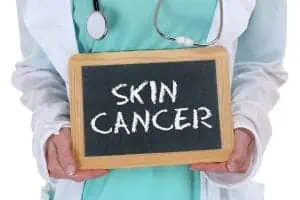
Skin cancer is the most common cancer in the U.S., and it is estimated that one in five Americans will develop skin cancer in their lifetime. Nearly 9,500 Americans are diagnosed with skin cancer every day, totaling nearly 3 million people. The two most common kinds of skin cancer are basal cell carcinoma and squamous cell carcinoma, which are also sometimes called nonmelanoma skin cancer. Rates of skin cancer are on the rise, with women experiencing the greatest increase in skin cancer numbers.
Basal cell carcinoma
The most common of all cancers, basal cell carcinoma accounts for more than 90 percent of all skin cancers in the U.S. It is a slow-growing cancer that is unlikely to spread to other parts of the body. Basal cell carcinoma has increased in recent years due to sunbathing and use of tanning salons. Though rarely fatal, it’s important to catch it in early stages. Look for pink bumps with these features:
- Pearly or waxy appearance
- Sunken center
- Irregular blood vessels on the surface
- A tendency to bleed easily after injury
Squamous cell carcinoma
Squamous cell carcinoma also rarely spreads but does so more often than basal cell carcinoma. It is the second most common skin cancer. Also, rarely deadly, it may spread to nearby tissue or recur if not caught early. Look for:
- Raised, dull-red skin lesion
- Thick-crusted scale
- Ulcerated appearance
Additional warning signs
Both basal and squamous cell cancers commonly develop on areas of the skin that are exposed to the sun. These include the head, face, neck, hands, and arms. The development of an actinic keratosis is an early warning sign of skin cancer. This is a precancerous skin lesion that may appear pink or red in color and rough or scaly and may become larger if not treated.
Non-surgical treatment with Electron Beam Therapy
These cancers often can be treated without surgery using a type of radiation called Electronic Beam Therapy (EBT). EBT is a state-of-the-art treatment that is particularly helpful for treating cancers near the eyes, ears, nose or lips. EBT is also recommended for patients who have other medical issues that make surgery less desirable.
EBT uses a very thin, non-penetrating electron beam to destroy cancer cells in the targeted area while allowing protection of healthy cells. EBT doesn’t go any deeper than the skin, which helps limit any side effects to organs and body tissue.
EBT is painless. Each treatment lasts only a few minutes. For most patients, treatment involves two to six weeks of daily EBT, depending on the size and location of cancer. Patients experience little to no discomfort, and side effects are typically limited to the treatment site. Best of all, EBT delivers a 90 to 98 percent cure rate, depending on the location of the skin cancer.
Water’s Edge Dermatology offers EBT in several of our offices, including:
Enjoy peace of mind and request an appointment today for a skin cancer screening. Request an appointment.





